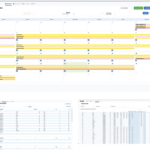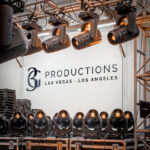“Here’s a fun fact — we sell to over 60 countries, and for a company started right here in the Rocky Mountains, that’s kind of neat.”
So says Greg Gundrum, VP of sales and marketing for Checkers Industrial Safety Products, the company behind all those orange and black cable protection ramps seen at events large and small.Checkers, which has probably done as much as any company to permanently rid the entertainment world of shoddy-looking plywood-and-duct tape cable coverings, is now celebrating 25 years in business with a new website, catalog and a new look marking the 25 years at more than a dozen trade events, including LDI, PLASA and InfoComm.
Beginnings
Company founder Steve Henry founded Checkers in 1987. He was working for his family-owned distributorship serving the mining industry and identified the need for a more durable wheel chock to keep in check large mining vehicles.
Instead of traditional wooden and rubber chocks, he developed a polyurethane one that was quickly put to use by many mines and, later, by other industries.
“Next, the company added cable protectors, warning whips [flags] and traffic safety lights, which are all part of our offerings today,” explains Gundrum, who joined the company in 2011 after gaining 15 years of international distribution experience with other companies.
“Being in industrial sales, I was aware of the Checkers name and reputation,” he says. “And I have enjoyed the opportunity to come here and work to develop and serve a variety of markets, including entertainment. It’s a great group of people I get to work with, and we’re all committed to growing the business, educating our distribution partners and end users on products and uses.”
Checkers products, Gundrum notes, are manufactured in Broomfield, CO and Mesa, AZ. Today around 125 people work for the company.
 Acquisitions and Growth
Acquisitions and Growth
Tonka Bay Equity Partners, a Minnesota-based private equity firm, acquired Checkers in Feb. 2011. Since then, Checkers has done some acquisitions itself, including the Aug. 2011 purchase of cable-protection rival of Yellow Jacket Inc., and the April acquisition of HBM Canada and C&C Signal — the latter two serve the needs of customers in the mining, oil and gas industries.
Henry, who is still an active member on Checkers’ board of directors, says the Yellow Jacket acquisition further complements the company’s cable management system. He noted that it “better positions the company to compete globally.”
Gundrum adds that the company is not planning to slow down. It is now actively striving to identify opportunities to develop new products that will cater to the needs of entertainment industry professionals, among others.
On the acquisition of Yellow Jacket, Gundrum says that while Checkers is widely known as the largest cable protective company, Yellow Jacket products are “almost Lego-like” in the way they can connect together to form ramps that adhere to American Disability Act guidelines.
Today, the live event industry accounts for a significant percentage of Checkers’ overall business, and Gundrum notes that, by identifying more applications for its products and increasing product offerings, Checkers has its eye on continuing that momentum into the future.
 Product Development
Product Development
The development of new products is a team effort — and not just within Checkers. “We are active in asking and listening to our customers about their needs in live entertainment. We recently implemented a field sales team who go out and conduct ‘voice of the customer’ sessions to understand the ever-changing needs,” Gundrum says. “It’s important that we have an active list of ideas to fill our new product development pipeline, and you’ll see up to four new products by the end of the year based on what people told us.”
Changing needs include “more is better” — especially when it comes to safety. Gundrum says as safety compliance evolves, so does Checker’s place in the live event industry. “You’re seeing more emphasis on safety in the live event industry, with inspectors keeping a sharper eye on things.” And it’s working in another way too. “Personal safety is number one, but increasingly protecting cords and cables is something production companies are wanting. Those bundles of wires are getting more complicated and more expensive, so making sure they aren’t run over by a forklift or stepped on is a matter of protecting their assets and bottom line. As we’re seeing larger stages and more complicated shows, those cables and the protection of them is more important than ever.”
 No More Duct Tape
No More Duct Tape
Educating even those working smaller events is another priority of the company. Gundrum points out that safety is sometimes an afterthought and, “the challenge is making people know to plan for safety from the beginning and not rely on quick, last minute fixes including duct tape or laying boards over cables.”
They are even working to improve on their standard products many might take for granted: cable management systems that have more gentle ramps for people to more easily shuffle over, and disabilities ramps with a more gradual slope for easier access.
“The material Checkers offers has several advantages over other materials, including its performance in hot weather conditions,” Gundrum says. “Sometimes when an event takes place on asphalt, temperatures get really high, and some materials do not hold up. Lids don’t fly flat, cables are crushed, and cable protectors don’t stand up to their intended load capacity, especially with repeat use. But ours always does.”
When it comes to cable protectors, one widely-held misconception, Gundrum notes, is that heavier is better. “We work at great length to engineer and design products to carry a certain load capacity, and we also consider the weight of the product. In addition to crewmembers having to carry and lay out the cable systems there are also freight costs to consider. Heavier-weight products, including those made from alternate materials, require higher transportation cost, driving up a customer’s overall expense. We take many items into consideration, including both material and structural design to provide our customers the greatest value. Also quite a bit of thought goes into the engineering to make these products crew-friendly.”


